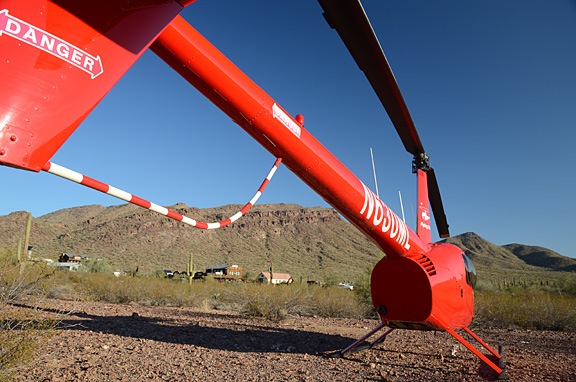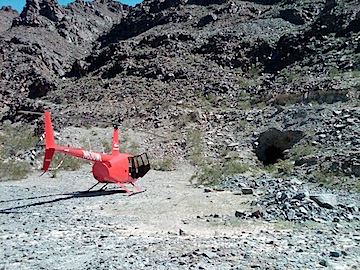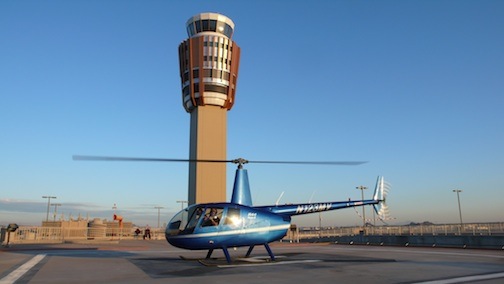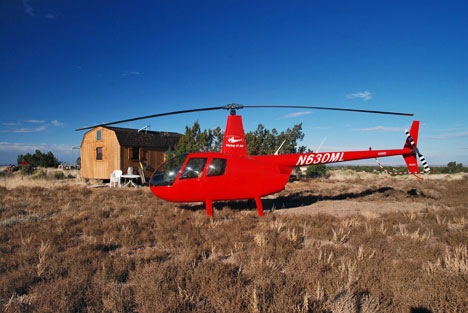A helicopter is almost an all-terrain vehicle.
As a helicopter pilot with a reasonable amount of experience, I’ve been in many situations that required me to land off-airport. And although I prefer landing on pavement rather than on non-paved areas, sometimes I can’t find a stretch of pavement near where I have to land. That means landing on grass, dirt, rocks — anything nature presents to me that’s relatively level and can support a helicopter.
As a new pilot, I was uncomfortable with off-airport landing zones (LZs) that either weren’t well established — by being one of the approved LZs used by my flight school — or unfamiliar. But over time, as I became accustomed to finding my own off-airport LZs and landing there, I also became more comfortable landing off airport.
This is what experience is all about.
Yesterday’s LZ
During the winter months, I operate an R44 in Arizona. I have a few regular clients who call me out to do survey or photo jobs out in the desert. They don’t always meet me at an airport or anywhere near any kind of pavement at all. It’s up to me, as pilot in command, to identify and land on a suitable spot.
Like yesterday’s spot:

I posted an image like this to Twitter yesterday with the comment:
I love landing zones like this.
I got a rather funny response from @Instructor[redacted], someone I didn’t know, who said:
That’s a lot of loose rocks. How does the aircraft escape damage in that environment?
I don’t mean to poke fun at [redacted] — a guy that uses a headshot of himself wearing an aviation headset with boom mic as his profile picture, seeming to indicate that he’s a pilot — but come on now. Was he kidding?
And that was my response:
You’re kidding, right?
I don’t think he was. I can’t find his tweet in my @Mentions stream this morning; it was saved in my Twitter client on my cellphone, though. I assume it was deleted. Perhaps he realized belatedly how silly his question was. That’s why I won’t use his name here. I don’t want to embarrass him.
But I do want to clear up a few misconceptions about landing zones, for other new pilots and instructors who don’t yet have much off-airport landing zone experience.
Rocks Don’t Fly
I’ll admit it: my first response to @Instructor[redacted] was rather snarky, something like:
Rocks generally remain on the ground and don’t damage aircraft.
Maybe my Twitter client has a snarkiness filter that prevented the tweet from being sent. More likely, it was because I was near that LZ and my 3G connection sucked. In any case, as far as I can tell, my snarky response never went to Twitter.
Which is a good thing. Snarky doesn’t teach. It embarrasses and belittles. If it had been delivered, I would have felt compelled to apologize.
But the point is this: rocks don’t fly. They remain on the ground and other than possibly scratching up your skids or hooking a skid to create a dynamic rollover hazard on departure, they’re pretty much harmless.
The LZ in this photo has nice small rocks. While there are some tiny ones — the kind that get caught in the tread of your shoes and are tracked inside the aircraft, forcing you to use the ShopVac back in the hangar to remove them — most are fist sized or smaller. None of these rocks are small or light enough to become airborne from downwash — at least not the downwash caused by a landing/hovering/departing R44. I can’t vouch for what a Huey might do to them, but I’m pretty sure that although movement is possible, flight is not.
What to Look for in an Off-Airport Landing Zone
When I tweeted that I loved landing zones like this, I wasn’t kidding. This landing zone has all the components I need to make a safe landing:
- Level terrain. While almost no off airport terrain is completely level, this one comes pretty darn close. So I don’t have to deal with the risks and concerns of a slope landing — which I absolutely hate doing.
- Smooth ground. Instructor[redacted] probably didn’t think the LZ was very smooth ground at all. But in the grand scheme of things, it is. I have seen (and landed on) ground pitted with holes and mounds of rock and scrub. This piece of land looks almost as if it had been graded smooth.
- Little dust. Rocks may not be a flight hazard, but dust is. With a ton of light dust, brownout conditions can occur on landing. I blogged about that here. With any amount of dust, the hazard is to the aircraft’s rotor blades. Dust is extremely corrosive and simply takes the paint off the blades. The more dusty landings, the less paint on the blades. Eventually, the blades need to be repainted. Mine have been repainted twice in 1350 hours and might get painted this week again. (It’s in for its annual now and I’ll let the mechanic decide; I think it can go another 6 months.) I should point out that simply landing in a mildly dusty area is not going to “damage” the aircraft to the point that it’s not flyable. (Actually, there’s a lot to say about dust and the potential for aircraft damage; it’ll make a good topic for a future post.) This LZ was not dusty at all, partially because it had rained a few days before and partially because the area was not trafficked.
- Good size. Although the area is surrounded by low bushes — mostly creosote — there’s enough clear area for my skids and tail rotor, as well as space on either side for pilot/passenger access.
- No obstacles. Sure, on the way in I did have to thread my way between a few tall saguaro cacti and a decent-sized palo verde tree. But there were enough options on my approach and departure paths to make a safe go-around if I needed to abort the landing. Departure would require more altitude than on a runway/taxiway, but not enough to qualify as a max performance takeoff over obstacles. Indeed, I was able to make my takeoff run at about 10-15 feet AGL, pretty darn close to the suggested profile of the Height-Velocity diagram for my aircraft.
- Photographic. Okay, so that’s not required for a good landing zone, but it is something that turns a good LZ into one I love. Why? So that when I share photos like the one above to help educate people about what helicopters can do, I can also show off how pretty the desert is. (And yes, how pretty my helicopter looks parked in it.)
So yes, I love this landing zone. Any helicopter pilot who has landed in worse places would.
In fact, I’d even go so far as to say that there’s nothing really wrong with this landing zone. It’s about as perfect as an unpaved off-airport landing zone could be. Hell, I’ve had on-airport landing zones that were less suitable than this.
Flight Instruction Failures?
And that brings me back to Instructor[redacted] with his headsetted face smiling out at Twitter users. Here’s a guy who appears to be a flight instructor, teaching other pilots how to fly. Yet he asked a very silly question that demonstrated his complete lack of knowledge and experience about landing zones.
And that bugs me.
People doing flight instruction should have better knowledge about what a helicopter can and can’t do. They should be able to identify what makes a suitable off-airport LZ.
I can only assume that this CFI was not properly trained. Perhaps his CFI lacked the same knowledge and understanding about off-airport LZs. Perhaps every CFI (and pilot) coming out of that flight school lacks this knowledge.
Does that mean these pilots won’t learn how to find and identify a suitable LZ until they get a job that requires them to do off-airport landings? If so, the flight school is doing a serious disservice to its students and their future employers. After all, when a pilot has the 1,000 hours of pilot-in-command flight time that most employers want, shouldn’t they already have the basic skills and experiences the employer should expect them to have? Isn’t landing off-airport one of those skills?
Maybe it’s because my flight school was based in Arizona and there are so many places to land out in the desert, but we were taught right from the start about off-airport landings. In fact, I can’t recall ever thinking that it was unusual to land somewhere other than at an airport or helipad.
After all, we’re talking about a helicopter here.
(I feel a major rant coming on, but I’ll stop right here, take a deep breath, and finish up instead.)
I hope Instructor[redacted] reads this. I hope that he understands that I’m not trying to poke fun at him or insult him. (After all, I did redact his name so he can remain anonymous.) I hope he learns from what I’ve written here.
But more important than that, I hope he talks to the Chief Flight Instructor at his school about their failure to properly educate him about off-airport LZs. I hope he helps them add some material to their curriculum to better educate their other students, pilots, and CFIs.
It’s a flight school’s job to churn out pilots — not guys and gals with pieces of paper that say they’re legal to fly. I sure do wish more flight schools would take that job seriously.












 N630ML at Howard Mesa, November 2008
N630ML at Howard Mesa, November 2008